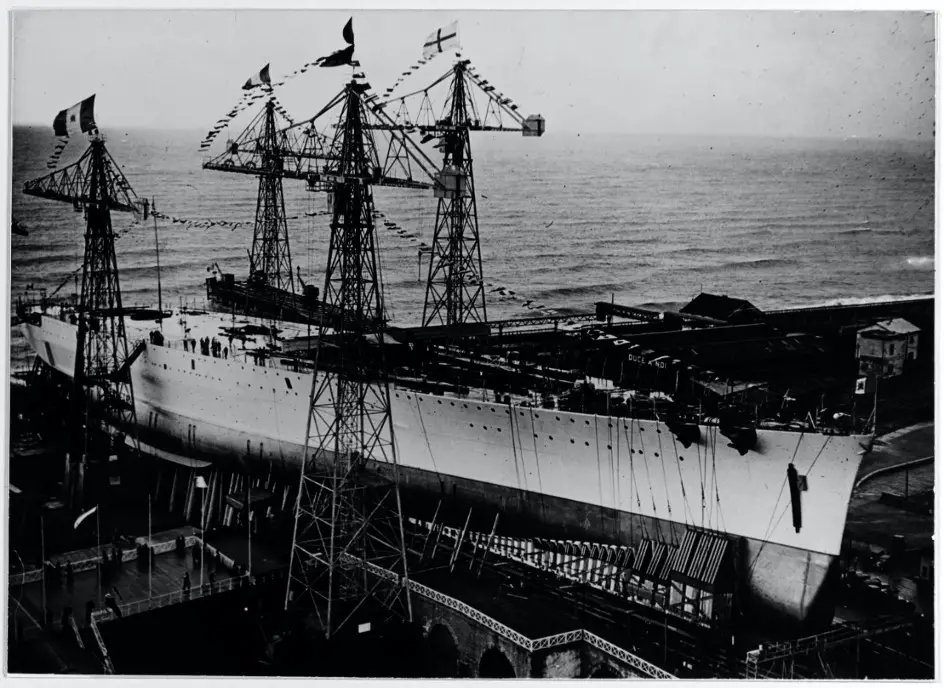Construction
In the 1930s, the attention of the Italian navy leadership shifted once again in favour of the construction of new battleships. After the radical reconstruction of the two Cavour class battleships, the laid down of the two-brand new Littorios and the start of the reconstruction of the two Duilios, the Regia Marina launched the ambitious naval programme of 1938. This one envisaged the construction of 16 ocean-going submarines,12 scout cruisers of the Capitani Romani class and two additional Littorio class battleships, the Roma and the Impero. The Impero was laid down in May 1938 in the Ansaldo shipyards of Genova. The ship was launched in November 1939 and soon the completion works began.

Launch of battleship Impero in November 1939
Wartime period
On the 10th of May 1940, Germany invaded France and in the space of a few days, the breakthrough in the Ardennes sector compromised the situation, paving the way for the collapse of France. During those days, Mussolini finally decided to throw Italy into the conflict, hoping for a rapid conclusion of the war and for some territorial gains. Fearing a naval or aerial bombardment over Genova, the Regia Marina decided to move the unfinished hull of the Impero away from the Frontline (being Genova relatively close to the French border).
On the 1st of June 1940, the massive Impero began its journey around the Italian peninsula, towed by a group of tugboats. The destination was Trieste, 1113 nautical miles far, where the battleship Roma was under construction. On the 9th of June, one day after the Italian declaration of war against France and Britain, the Impero entered the harbour of Brindisi, in the lower Adriatic. The unfinished battleship was safe for the moment. The journey towards Trieste did not resume immediately. With the war declared, the navigation of the Impero could have faced submarine attacks and in those weeks, there were not enough warships available in the area to escort the unfinished battleship. The collapse of France probably led the Navy leadership to opt for a “wait-and-see” approach, hoping for a rapid conclusion of the war. This eventually did not happen and the summer of 1940 passed with the future of the Impero remaining uncertain. In October 1940, the Regia Marina decided to carry out the necessary works to allow the uncompleted battleship to move autonomously and complete the transfer voyage towards Trieste. For this reason, workers and materials arrived in Brindisi to finish the job. However, the Taranto raid of November 1940 further delayed the schedule. To repair the damaged battleship Littorio, the Regia Marina utilized the brand-new rudder originally built for the Impero (and not yet mounted). The Impero ultimately received the repaired rudder of the Littorio which was mounted in June 1941.

The ship at anchor in Brindisi
Following the damages suffered by battleship Vittorio Veneto during the events of Gaudo and Matapan, other spare parts were taken from the Impero to repair the damaged sister ship. Due to these delays, the completion of Impero’s machinery was ultimate at the end of 1941. In January 1942, the ship finally left Brindisi, escorted by a formation of old torpedo boats and submarines, during the voyage, Impero’s machinery was able to increase speed to 17,5 knots. On the 27th of January, the Impero entered the drydock in Venezia to undertake further maintenance to the hull. However, the transfer to Trieste could only be completed in November 1942.
At this stage, the tide of the Mediterranean war had definitively turned in favour of the allies, and the battleship force of the Regia Marina was forced to sit in the harbour due to the shortages of naphtha.
In June 1943 the Regia Marina suspended all further works on battleships, aircraft carriers and cruisers. The Impero thus remained untouched in Trieste until the armistice of September 1943 between Italy and the allies. On the 9th of September, the Germans captured the unfinished hull and started to dismantle the ship to retrieve metals and spare parts. In April 1945, German engineers mined the ship before the general withdrawal of the Wehrmacht from northern Italy. The Impero remained semi sunk in Trieste until 1949 when the hull was refloated and brought to the scrapyard.

The ship after being refloated in 1949
Aircraft carrier Impero?
Inside the Nay Museum of Venice, there are several ship models, among them, there’s the model of an aircraft carrier which was believed to be the Aquila, until the early 2000s. In 2005, a group of navy officers and historians analysed the model and found out that the shape and the dimensions of the hull (scale 1:200), could not match those of the Aircraft carrier Aquila. The ship represented by the model was certainly bigger than the Aquila and the shape of the hull matched that of a Littorio class battleship.
 This suggests that at some point during the war (probably in late 1940), the Regia Marina studied the possibility to transform the Impero (certainly not the Roma) into an aircraft carrier. Unfortunately, there is no other evidence of this, and such a project certainly did not go beyond the design phase.
This suggests that at some point during the war (probably in late 1940), the Regia Marina studied the possibility to transform the Impero (certainly not the Roma) into an aircraft carrier. Unfortunately, there is no other evidence of this, and such a project certainly did not go beyond the design phase.
Sources
Bagnasco, E., & Cernuschi, E. (2006). La Portaerei Impero? STORIA MILITARE n.152, 51-59.
Bagnasco, E., & De Toro, A. (2020). Le navi da battaglia classe “Littorio” 1937-1948. Roma: Ufficio storico della Marina Militare.